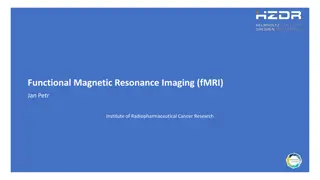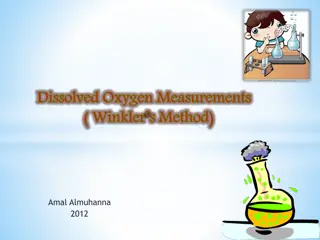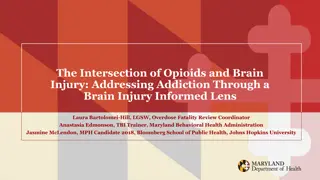Essential Medical Oxygen: Supply and Safety Guidelines
Medical oxygen is crucial in healthcare, especially during the COVID-19 pandemic. This resource explains its importance, use in various treatments, safety measures, and storage requirements. Learn about the significance of high-grade oxygen and the process of oxygen therapy delivery. Enhance your un
2 views • 48 slides
Comprehensive Overview of Brain Imaging Techniques and Anatomy
Explore the world of brain imaging with functional MRI, MRI techniques, brain anatomy, neuronal activation, and brain vasculature explained in detail, shedding light on brain regions and their functions.
9 views • 53 slides
Understanding Oxygen Diffusion Rate Measurement in Plant Roots
Measurement of oxygen diffusion rate in plant roots is crucial for assessing soil oxygen levels and aeration conditions. The Oxygen Diffusion Rate (ODR) method utilizes a platinum microelectrode to simulate roots, allowing for the calculation of oxygen flux at the root-soil interface. By monitoring
1 views • 5 slides
Understanding the Brain Stem and its Functions
Explore the intricate structures of the brain stem, including the midbrain, pons, and medulla oblongata. Learn about the functions of the cerebellum, its role in controlling postural reflexes and producing skilled movements. Discover the thick tracts connecting the cerebellum to the brain stem and t
7 views • 20 slides
Understanding the Brain: Stem, Midbrain, Pons, Medulla, and Cerebellum Functions
Explore the complex structures and functions of the brain, including the brain stem, midbrain, pons, medulla, and cerebellum. Discover how these regions play crucial roles in controlling reflexes, movements, and vital functions like respiration and posture. Learn about the thick tracts connecting th
7 views • 21 slides
Dissolved Oxygen Measurements and Factors Affecting Oxygen Levels
Understanding the importance of dissolved oxygen in water is crucial for the survival of aquatic plants and animals. Factors such as chemical reactions, temperature, pressure, and light penetration influence oxygen levels. The Winkler method is commonly used for dissolved oxygen measurements. This m
4 views • 11 slides
The Truth Revealed Does Cannabis Harm Brain Cells.docx
The Truth Revealed: Does Cannabis Harm Brain Cells?\nIn recent years, the debate surrounding the effects of cannabis on brain health has intensified. With the growing popularity of cannabis and the increasing accessibility of products from online weed dispensaries and marijuana dispensaries, it\u201
9 views • 3 slides
Brain Injury Services: Empowering Recovery and Support
At Brain Injury Services, we are committed to making a positive difference in the lives of individuals affected by brain injury. Through our comprehensive support services, compassionate care, and commitment to empowerment, we empower survivors to overcome obstacles, reclaim their independence, and
6 views • 7 slides
Maintaining Dissolved Oxygen Levels for Black Bass in Livewells
Dissolved oxygen is crucial for the health of black bass in livewells, especially during warmer months. This presentation explores the importance of oxygen equipment to maintain sufficient oxygen levels, recommends system components, and provides guidelines for installation, operation, and safety me
0 views • 14 slides
Exploring Brain Waves Through EEG Analysis
Delve into the world of brain waves with EEG, EKG, and EMG measurements. Learn how to analyze brain wave data using mathematical processes like Fast Fourier Transform (FFT) and Power Spectral Density (PSD). Discover the significance of different frequencies in brain wave signals and how they reflect
1 views • 13 slides
Evolution of Oxygen Flowrates in Healthcare Settings
Discussions around oxygen flowrates in healthcare facilities, especially in the context of the COVID-19 pandemic, highlight the need for a review of current guidelines. The existing (S)HTM 02-01 guidance, developed around 20 years ago, is being reevaluated to align with modern clinical practices. Pr
0 views • 11 slides
Understanding Intimate Partner Violence and Brain Injury Connections
The link between intimate partner violence (IPV) and brain injury is significant, with studies showing a high prevalence of brain injuries among IPV survivors, particularly women. Common types of IPV causing brain injury include hits to the head, strangulation, and banging the head against objects.
1 views • 23 slides
Importance of Transport System in Animals for Oxygen Supply
Animals require a transport system to meet tissue oxygen demands efficiently. The size limit for oxygen diffusion alone is around 1 mm due to the proportional increase in radius and diffusion properties. Blood is crucial for transporting oxygen, nutrients, waste products, cells, and heat, as well as
0 views • 17 slides
Comprehensive Guide to Oxygen Storage and Handling Methods
Explore the various methods of storing and handling oxygen, including types of storage devices, sources of medical oxygen, liquid oxygen containers, and cryogenic liquid cylinders. Learn about the different containers used, storage quantities, vaporization rates, and safety measures involved in stor
0 views • 61 slides
Brain Oxygen Optimization in Severe TBI - Protocol Summary
In the severe traumatic brain injury (TBI) protocol, intracranial monitors measuring ICP and PbtO2 are placed within 12 hours of injury. Procedures include FiO2 challenges to check PbtO2 reliability and assess cerebral physiology. Challenges involving FiO2, MAP, and CO2 help guide ventilator setting
2 views • 27 slides
Importance of Oxygen Therapy in Managing Respiratory Illnesses
Oxygen therapy is crucial in treating hypoxemia and saving lives, especially in patients with severe acute respiratory infections like COVID-19. This module covers the significance of oxygen therapy, indications for its use, methods to measure blood oxygen levels, and how to titrate oxygen therapy e
2 views • 22 slides
Unlocking the Power of the Human Brain: Insights from 11th ICPAR Annual Training Conference
Delve into the intricacies of the human brain at the upcoming 11th ICPAR Annual Training Conference themed around "Brain Power to Embrace Change and Emotional Stability." Explore the control center of our minds, the cerebral cortex, the limbic system, and the role of neurons in conscious mental reac
0 views • 57 slides
Oxygen Therapy in Veterinary Practice
Oxygen therapy is a crucial intervention in veterinary medicine, especially in emergency situations to address hypoxia and increase oxygen delivery to tissues. It involves delivering high concentrations of oxygen to optimize oxygen levels in the blood. Indications for oxygen therapy include hypoxia
1 views • 15 slides
Understanding Photosynthesis and Measuring Dissolved Oxygen
Explore the process of photosynthesis and the importance of dissolved oxygen within a photosynthetic system. Discover how environmental factors like light intensity influence the rate of photosynthesis, and learn how to measure dissolved oxygen using the SensorLab air pressure sensor. Engage in an e
0 views • 22 slides
Dissolved Oxygen Measurement and Factors Affecting Oxygen Levels
The content highlights the importance of measuring dissolved oxygen levels in water bodies for aquatic life survival. It explains the factors influencing oxygen concentrations, the principles of Winkler's method for measurement, required materials, and the testing procedure involved. The significanc
0 views • 11 slides
Maintaining Brain Health and Cognitive Function: Key Factors and Risks
Aging well and maintaining brain health require a combination of genetic, environmental, and lifestyle factors. While age-related changes in memory and learning may occur, adopting a healthy lifestyle, avoiding risks like smoking and excessive alcohol use, and being aware of how medicines can impact
0 views • 23 slides
Brain Oxygen Optimization in Severe Traumatic Brain Injury (BOOST3) Trials Overview
Overview of the BOOST3 trials focusing on brain oxygen optimization in severe traumatic brain injury patients. The trials involve multiple PIs, training sessions, and hands-on ancillary studies. Various design principles and organizational values are emphasized, with grant awards distributed to diff
0 views • 13 slides
Brain Oxygen Optimization in Severe TBI Phase 3: BOOST-3 Study Details at University of Michigan
Explore the BOOST-3 trial led by Erin Bengelink, focusing on brain oxygen optimization in severe Traumatic Brain Injury (TBI) Phase 3. Discover study materials, milestones, regulatory parameters, and training resources to facilitate your involvement in this crucial research project. Access the BOOST
1 views • 22 slides
Impact of Dissolved Oxygen and Flow Rate on Watercress Germination and Growth
A study by Claire Cleveland and Dr. Laurie Mauger explores the effects of dissolved oxygen concentration and flow rate on watercress germination and growth. The research includes ecological markers, existing evidence, hypothesis, experimental design, and anecdotal results indicating that watercress
0 views • 15 slides
Understanding Metabolic Rate in Biology: Measurement and Importance
Metabolic rate, the energy consumed by an organism in a specific time period, can be measured through heat energy, oxygen consumption, and carbon dioxide release. Various tools like calorimeters and respirometers are used for this purpose. The delivery of oxygen through efficient transport systems i
0 views • 28 slides
The Intersection of Opioids and Brain Injury: Addressing Addiction Through a Brain Injury Informed Lens
Exploring the correlation between traumatic brain injury (TBI) and the opioid crisis, this content delves into the alarming statistics of opioid overdoses and their impact on individuals with brain injuries. Highlighting the overlap and consequences of these two major health issues, it sheds light o
0 views • 45 slides
Understanding Arterial Blood Gases and Oxygen Delivery Devices
Arterial blood gases (ABG) are obtained from arteries to assess acid-base balance and blood oxygen levels. The pH, PaCO2, PaO2, HCO3, and SaO2 are crucial values on an ABG report. These values reflect the blood's acid-base status, carbon dioxide levels, oxygen saturation, and more. The buffer system
0 views • 25 slides
Oxygen Therapy: Fundamentals and Practice Overview
Oxygen therapy is a vital intervention for individuals with respiratory conditions like COPD, pneumonia, asthma, and more. This practice involves administering supplemental oxygen to improve oxygen levels in the body, leading to enhanced energy levels and overall quality of life. Precautions and con
0 views • 28 slides
Understanding Oxygen: Uses, Effects, and Importance in Living Organisms
Oxygen, a vital nonmetallic element, plays a crucial role in various processes essential for living organisms. It is involved in energy production, metabolism, immune system support, and more. However, the lack of oxygen can lead to serious conditions like hypoxia. Learn about the uses, effects, and
0 views • 37 slides
Determining Percent Oxygen in Air Lab Guide
This laboratory exercise focuses on determining the percentage of oxygen in air through room volume measurement, sample weight analysis, and chemical reaction calculations. The background information covers the importance of oxygen, historical discoveries, combustion reactions, and the debunking of
0 views • 12 slides
Understanding Dissolved Oxygen Sag Curves in Environmental Engineering
Understanding the Dissolved Oxygen Sag Curve in streams is crucial for predicting oxygen depletion due to organic carbon input. Models like the Streeter-Phelps Model help in estimating minimum oxygen levels and distance downstream where deficits occur. This involves concepts like BOD, DO, mathematic
0 views • 14 slides
Oxygen Therapy in Emergency Medicine
Oxygen therapy is crucial in emergency medicine for treating hypoxemia and improving oxygenation levels in patients. It is essential for conditions like acute hypoxemia, carbon monoxide poisoning, and shock. Various oxygen delivery devices are used to administer oxygen effectively, such as nasal pro
0 views • 27 slides
Lessons Learned in Brain Oxygen Optimization for Severe TBI Phase 3 Protocol
Screening, enrollment, and inclusion/exclusion criteria insights for the Brain Oxygen Optimization in Severe Traumatic Brain Injury (TBI) Phase 3 Protocol are discussed. Key points include handling urgent patient queries, guidelines on hypotension and hypoxia, pupil assessment considerations, and su
0 views • 20 slides
Comprehensive Guide to Oxygen Therapy and Safety Precautions
Oxygen therapy is a crucial medical intervention for various conditions, such as hypoxia, impaired gas exchange, and heart failure. This guide covers the administration of oxygen, types of oxygen supply, safety precautions, and devices used for oxygen delivery. Safety measures include avoiding smoki
0 views • 16 slides
Understanding Oxygen Inhalation in Medical Treatment
Oxygen inhalation is a vital medical intervention to treat low blood oxygen levels in children with respiratory issues. It helps manage hypoxia, maintain oxygen levels in the blood, and support normal cellular function. Common indications include cyanosis, breathlessness, anemia, and exposure to low
0 views • 44 slides
Exploring Computational Theories of Brain Function
In this series of images and text snippets, the discussion revolves around the emerging field of computational theories of brain function. Various aspects such as symbolic memories, the relationship between the brain and computation, the emergence of the mind from the brain, and computational thinki
0 views • 53 slides
Hyperbaric Oxygen Therapy for Traumatic Brain Injury (TBI) - Benefits and Mechanisms Explained
Hyperbaric Oxygen Therapy (HBOT) is a cutting-edge treatment that involves providing oxygen in a pressurized environment to enhance oxygenation of body tissues beyond what red blood cells can deliver. This therapy, administered under controlled conditions, offers various physiological and cellular b
0 views • 15 slides
Brain Oxygen Optimization in Severe TBI: Adverse Events Analysis
This study led by Dr. Robert Silbergleit focuses on adverse events in brain oxygen optimization for severe Traumatic Brain Injury (TBI) patients. It outlines key points for reporting adverse events, discusses relatedness algorithms, and presents scenarios to analyze adverse events occurrence post-en
0 views • 24 slides
Comprehensive Guide to Oxygenation in Respiratory Care
Oxygenation is a vital aspect of medical care, involving the process of delivering oxygen to the body's cells. It includes measures such as Arterial Oxygen Saturation, Oxygen Delivery, Oxygen Consumption, and Oxygen Extraction. Understanding hypoxia and hypoxemia, as well as the mechanisms of hypoxe
0 views • 28 slides
Understanding Oxygen Transport in the Respiratory System
Explore the intricate process of oxygen transport in the respiratory system, covering topics such as the composition of air, gaseous transport, factors affecting oxygen-hemoglobin dissociation, atmospheric air composition, diffusion of gases, effects of water vapor, and the methods of oxygen transpo
0 views • 37 slides







































